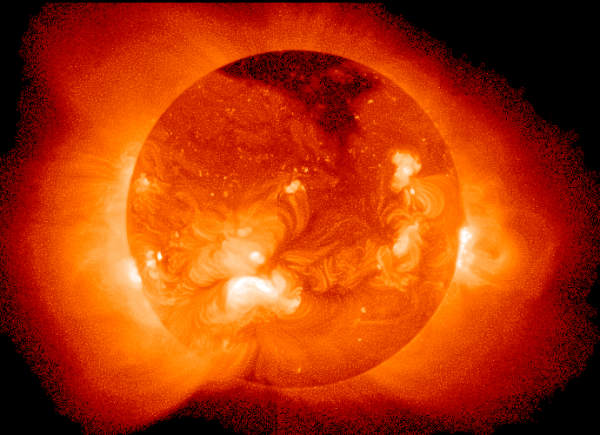Solar Explosions Modeled in Computers
| Marc Maligalig | | Sep 25, 2014 05:42 AM EDT |
(Photo : Wikimedia Commons) The Sun seen in X-rays
Swiss scientists have turned to computers to demonstrate how strong solar flares disable power and communication grids on Earth.
Using model calculations, a team has shown that the shorter intervals between two flares in the solar atmosphere, the more likely it is that the second explosion will be stronger than its predecessor.
Like Us on Facebook
Researchers examined what happens when explosions occur on the surface of the Sun. They were able to accurately recreate the temporal succession and statistical size distribution of the solar flares with a computer model.
The team that made these findings was led by Professor Hans Jürgen Herrmann. He and his colleagues are from the Eldgenössische Technische Hockshchule Zürich, also known as the Swiss Federal Institute of Technology Zurich.
The energy expelled from solar flares is millions of times more powerful than the energy generated in the eruptions of volcanoes. The explosions send out mass from the corona, the perimeter of the Sun's atmosphere.
Coronal mass ejections that hit the Earth could cause geomagnetic storms. Electrical plants, satellites and radio traffic can all be disrupted by the dangerous storms.
The strongest solar eruption in recorded history occurred in 2003. This massive solar storm resulted in power failures in southern Sweden. Airborne planes had to be redirected to other airports as communications broke down above the Polar Regions.
Herrmann, a professor at the Institute for Building Materials, said the Sun wasn't actually the focus of the study. The expert in computer physics and theoretical physicist developed a technique to observe events from a wide range of diverse fields.
Patterns in avalanches, earthquakes and the stock market are similar to the patterns in solar flares.
"Solar explosions do not, of course, have any connection with stock exchange rates," said Hermann.
"Nevertheless, they do behave in a similar way: they can interlock until they reach a certain threshold value before discharging. A system therefore does not continuously release the mass or energy fed into it, but only does so in bursts."
Tagssolar power, solar energy, Solar Flare, Sun, Sunlight, coronal mass ejections, Satellite, Radio, power
©2015 Chinatopix All rights reserved. Do not reproduce without permission
EDITOR'S PICKS
-

Did the Trump administration just announce plans for a trade war with ‘hostile’ China and Russia?
-

US Senate passes Taiwan travel bill slammed by China
-

As Yan Sihong’s family grieves, here are other Chinese students who went missing abroad. Some have never been found
-

Beijing blasts Western critics who ‘smear China’ with the term sharp power
-

China Envoy Seeks to Defuse Tensions With U.S. as a Trade War Brews
-

Singapore's Deputy PM Provides Bitcoin Vote of Confidence Amid China's Blanket Bans
-

China warns investors over risks in overseas virtual currency trading
-

Chinese government most trustworthy: survey
-

Kashima Antlers On Course For Back-To-Back Titles
MOST POPULAR
LATEST NEWS
Zhou Yongkang: China's Former Security Chief Sentenced to Life in Prison

China's former Chief of the Ministry of Public Security, Zhou Yongkang, has been given a life sentence after he was found guilty of abusing his office, bribery and deliberately ... Full Article
TRENDING STORY

China Pork Prices Expected to Stabilize As The Supplies Recover

Elephone P9000 Smartphone is now on Sale on Amazon India

There's a Big Chance Cliffhangers Won't Still Be Resolved When Grey's Anatomy Season 13 Returns

Supreme Court Ruled on Samsung vs Apple Dispute for Patent Infringement

Microsoft Surface Pro 5 Rumors and Release Date: What is the Latest?










